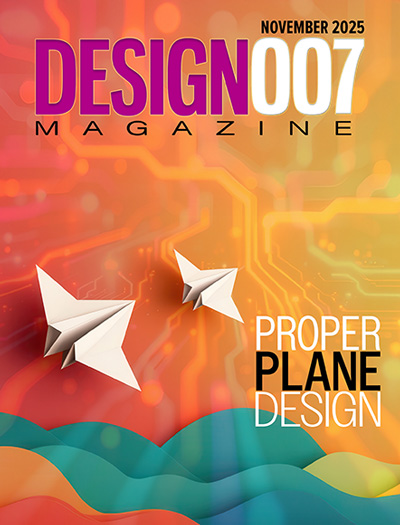-

- News
- Books
Featured Books
- design007 Magazine
Latest Issues
Current Issue
Designing Proper Planes
Without planes, designers would have to create thousands of traces to accomplish the same objectives. Power planes provide low impedance and stable power, and ground planes stabilize reference voltage, improve thermal performance, and help preclude EMI issues.

Power Integrity
Current power demands are increasing, especially with AI, 5G, and EV chips. This month, our experts share “watt’s up” with power integrity, from planning and layout through measurement and manufacturing.

Signal Integrity
If you don’t have signal integrity problems now, you will eventually. This month, our expert contributors share a variety of SI techniques that can help designers avoid ground bounce, crosstalk, parasitic issues, and much more.
- Articles
- Columns
- Links
- Media kit
||| MENU - design007 Magazine
DipTrace 3.0 Implements Ucamco's Gerber X2
May 19, 2016 | UcamcoEstimated reading time: 2 minutes
Together with leading software development company Novarm, Ucamco is delighted to announce the stable release of DipTrace 3.0, the latest generation of Novarm's intuitive, powerful and affordable PCB layout solution for the world's electronic engineers. DipTrace 3.0 is the result of Novarm's understanding of how EDA software is used in the field, its active involvement in the electronic designers' community, and the fact that it listens carefully to its customers. Novarm has responded to its marketplace with a raft of new developments that significantly improve its software's overall performance, ease of use and reliability. This includes fully implementing Gerber X2 for more robust design data transfer, as Novarm's CEO and Senior Software Developer Stanislav Ruev comments: “Gerber X2 manufacturing outputs improve the reliability of CAD-CAM data transfer, ensuring maximum understanding between the designer and the PCB manufacturer”.
Gerber X2 builds on Extended Gerber, the PCB industry's de facto standard image format, to bring unprecedented clarity to the CAD-to-CAM data transmission process. It does this by fully supporting the well-known Extended Gerber image format with a new format for the additional design information, that is clear, unequivocal and automatically machine-readable. This includes details on stackup, the functions of layers and individual features such as pads, and other parameters.
“We are delighted that DipTrace 3.0 is now supporting Gerber X2”, says Karel Tavernier, Managing Director of the Gerber format's custodian and developer, Ucamco. “With this development, Novarm joins the growing number of PCB design software houses that support Gerber X2 because they recognise the importance of absolute data and communications clarity when transferring PCB design data from one company to another. By providing designers with a robust, unequivocal and known language with which to communicate easily and clearly with their manufacturing partners, we and Novarm deliver unprecedented capabilities to the industry-wide CAD-to-CAM data transfer process in particular, and to the future of the PCB industry in general”.
Ucamco confirms that the Gerber X2 output of DipTrace 3.0 has been fully verified and conforms to the X2 specification.
About Ucamco
Ucamco (formerly Barco ETS) is a market leader in PCB CAM software, photoplotting and direct imaging systems, with a global network of sales and support centers. Headquartered in Ghent, Belgium, Ucamco has over 25 years of ongoing experience in developing and supporting leading-edge photoplotters and front-end tooling solutions for the global PCB industry. Key to this success is the company's uncompromising pursuit of engineering excellence in all its products. Ucamco also owns the IP rights on the Gerber File Format through its acquisition of Gerber Systems Corp. (1998).
Testimonial
"We’re proud to call I-Connect007 a trusted partner. Their innovative approach and industry insight made our podcast collaboration a success by connecting us with the right audience and delivering real results."
Julia McCaffrey - NCAB GroupSuggested Items
PCB Design Software Market to Hit $12.11 Billion by 2033, Growing at a CAGR of 13.77%
11/14/2025 | Globe NewswireThe PCB Design Software Market Size was valued at USD 4.32 Billion in 2025E and is expected to reach USD 12.11 Billion by 2033 and grow at a CAGR of 13.77% over the forecast period 2026-2033.
Zuken Opens Call for Papers for ZIW Americas 2026
11/13/2025 | ZukenZuken USA, Inc. opens the Zuken Innovation World (ZIW) Americas 2026 Call for Papers to help engineers, managers, and leaders showcase proven results and advance industry best practices. ZIW is Zuken USA’s semi-annual Digital Engineering conference on electrical and electronic design for engineers, managers, and industry leaders. It focuses on current practices and emerging trends with practical takeaways.
Innatera Signs Joya as ODM Customer, Bringing Neuromorphic Edge AI into Everyday Connected Products
11/13/2025 | PRNewswireInnatera, the leader in brain-like neuromorphic computing for ultra-low-power intelligence at the sensor edge, today announced that Xiamen Joyatech Co., Ltd. has become its first Original Design Manufacturer (ODM) customer.
Advanced Electronics Packaging Digest: Third Issue Arrives November 17
11/12/2025 | I-Connect007The third issue of Advanced Electronics Packaging Digest launches Monday, November 17. This issue continues AEPD’s mission to deliver forward-looking analysis and insider perspectives on the technologies reshaping advanced electronics packaging. Among the highlights is a review of IMPACT 2025, where discussions on component-to-system-level integration took center stage as experts explored the challenges and breakthroughs driving advanced packaging technologies.
Electronic Design Automation (EDA) Market Size to Reach $811.1 Million by 2030
11/12/2025 | PRNewswireThe Global Electronic Design Automation (EDA) Market was estimated to be worth USD 541 Million in 2023 and is forecast to a readjusted size of USD 811.1 Million by 2030 with a CAGR of 6.4% during the forecast period 2024-2030.


